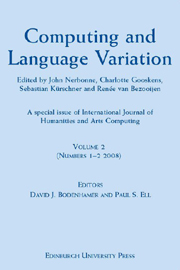Book contents
- Frontmatter
- Contents
- From the Editors
- Notes on Contributors
- 1 Introduction: Language Variation Studies and Computational Humanities
- 2 Panel Discussion on Computing and the Humanities
- 3 Making Sense of Strange Sounds: (Mutual) Intelligibility of Related Language Varieties. A Review
- 4 Phonetic and Lexical Predictors of Intelligibility
- 5 Linguistic Determinants of the Intelligibility of Swedish Words among Danes
- 6 Mutual Intelligibility of Standard and Regional Dutch Language Varieties
- 7 The Dutch-German Border: Relating Linguistic, Geographic and Social Distances
- 8 The Space of Tuscan Dialectal Variation: A Correlation Study
- 9 Recognising Groups among Dialects
- 10 Comparison of Component Models in Analysing the Distribution of Dialectal Features
- 11 Factor Analysis of Vowel Pronunciation in Swedish Dialects
- 12 Representing Tone in Levenshtein Distance
- 13 The Role of Concept Characteristics in Lexical Dialectometry
- 14 What Role does Dialect Knowledge Play in the Perception of Linguistic Distances?
- 15 Quantifying Dialect Similarity by Comparison of the Lexical Distribution of Phonemes
- 16 Corpus-based Dialectometry: Aggregate Morphosyntactic Variability in British English Dialects
3 - Making Sense of Strange Sounds: (Mutual) Intelligibility of Related Language Varieties. A Review
Published online by Cambridge University Press: 12 September 2012
- Frontmatter
- Contents
- From the Editors
- Notes on Contributors
- 1 Introduction: Language Variation Studies and Computational Humanities
- 2 Panel Discussion on Computing and the Humanities
- 3 Making Sense of Strange Sounds: (Mutual) Intelligibility of Related Language Varieties. A Review
- 4 Phonetic and Lexical Predictors of Intelligibility
- 5 Linguistic Determinants of the Intelligibility of Swedish Words among Danes
- 6 Mutual Intelligibility of Standard and Regional Dutch Language Varieties
- 7 The Dutch-German Border: Relating Linguistic, Geographic and Social Distances
- 8 The Space of Tuscan Dialectal Variation: A Correlation Study
- 9 Recognising Groups among Dialects
- 10 Comparison of Component Models in Analysing the Distribution of Dialectal Features
- 11 Factor Analysis of Vowel Pronunciation in Swedish Dialects
- 12 Representing Tone in Levenshtein Distance
- 13 The Role of Concept Characteristics in Lexical Dialectometry
- 14 What Role does Dialect Knowledge Play in the Perception of Linguistic Distances?
- 15 Quantifying Dialect Similarity by Comparison of the Lexical Distribution of Phonemes
- 16 Corpus-based Dialectometry: Aggregate Morphosyntactic Variability in British English Dialects
Summary
INTRODUCTION
Two basic questions
In this paper we ask two questions, which superficially seem to ask the same thing but in actual fact do not. First, we ask to what degree two languages (or language varieties) A and B resemble each other. The second question is how well a listener of variety B understands a speaker of variety A.
When we ask to what degree two language varieties resemble one another, or how different they are (which is basically the same question), it should be clear that the answer cannot be expressed in a single number. Languages differ from each other not in just one dimension but in a great many respects. They may differ in their sound inventories, in the details of the sounds in the inventory, in their stress, tone and intonation systems, in their vocabularies, and in the way they build words from morphemes and sentences from words. Last, but not least, they may differ in the meanings they attach to the forms in the language, in so far as the forms in two languages may be related to each other. In order to express the distance between two languages, we need a weighted average of the component distances along each of the dimensions identified (and probably many more). So, linguistic distance is a multidimensional phenomenon and we have no a priori way of weighing the dimensions.
The answer to the question how well listener B understands speaker A can be expressed as a single number. If listener B does not understand speaker A at all, the number would be zero. If listener B gets every detail of speaker A's intentions, the score would be maximal.
- Type
- Chapter
- Information
- Computing and Language VariationInternational Journal of Humanities and Arts Computing Volume 2, pp. 39 - 62Publisher: Edinburgh University PressPrint publication year: 2009



